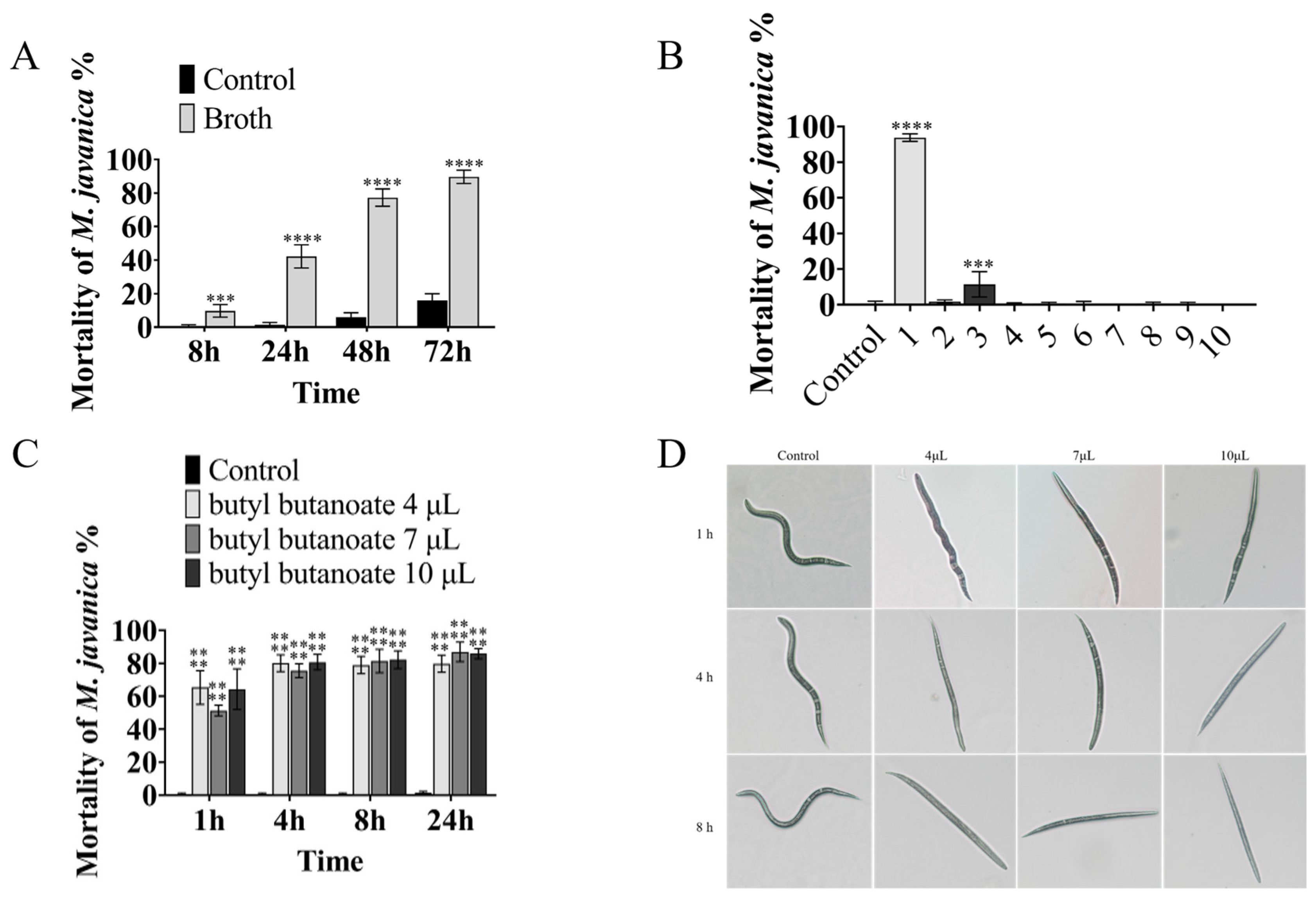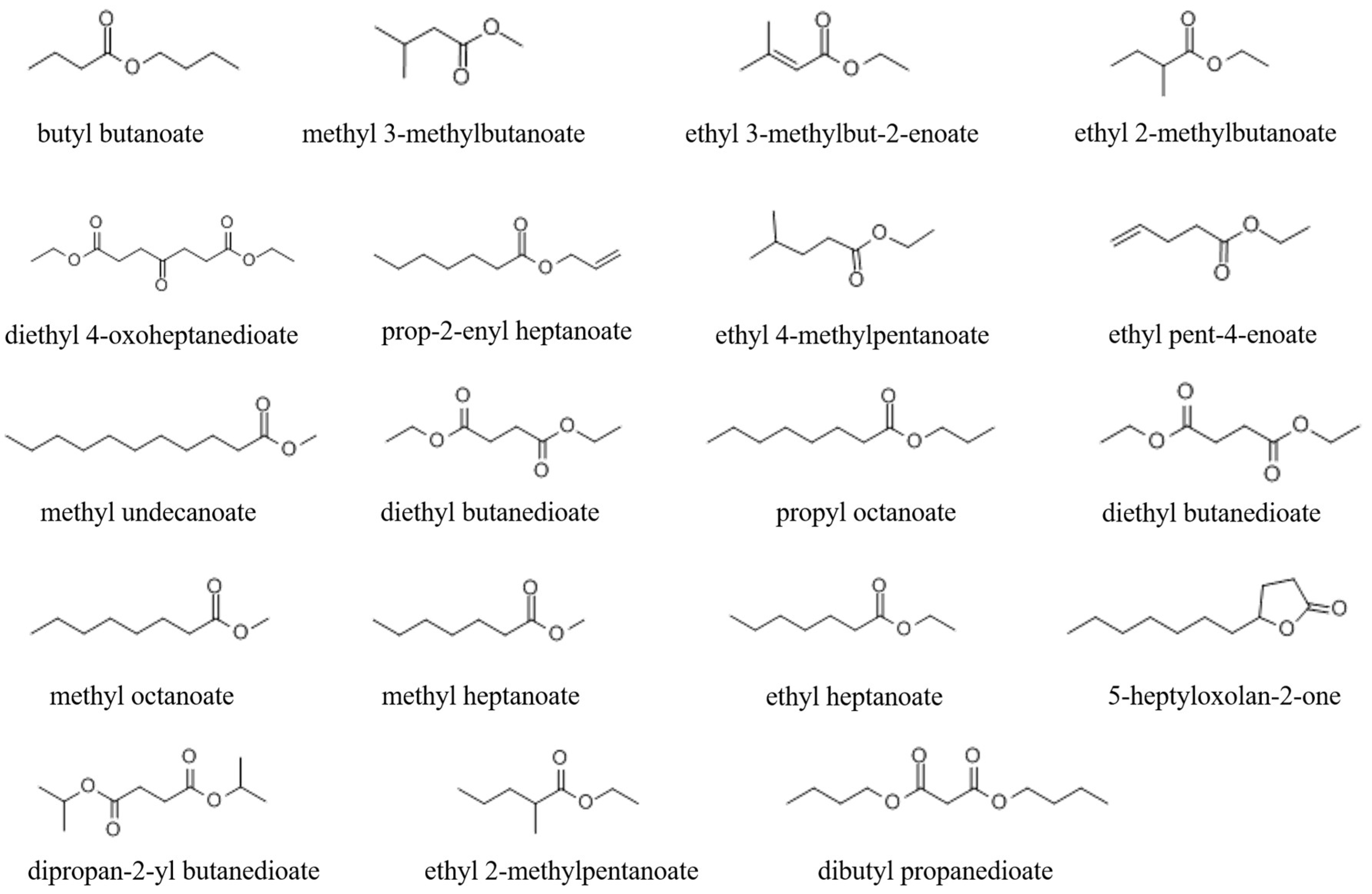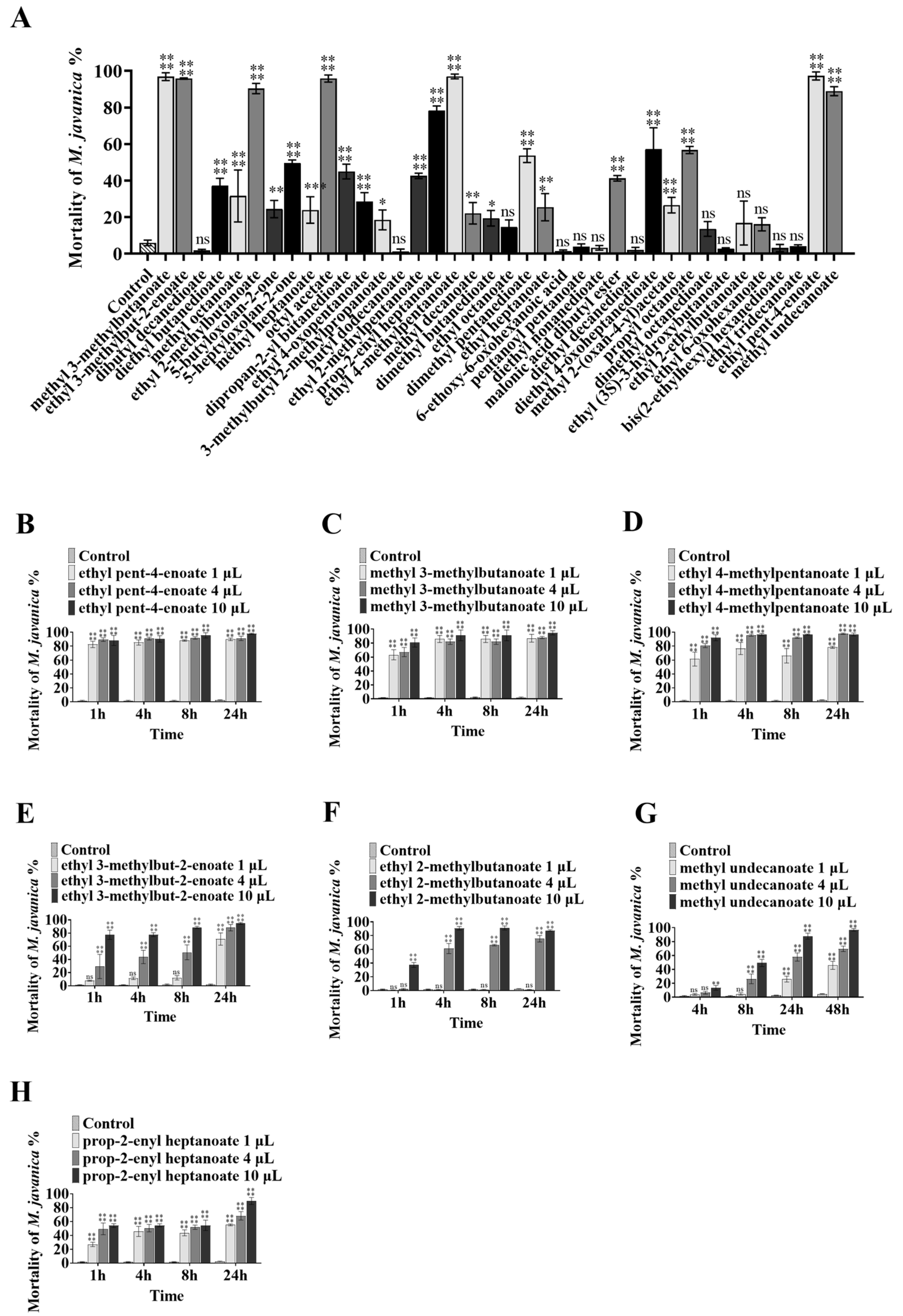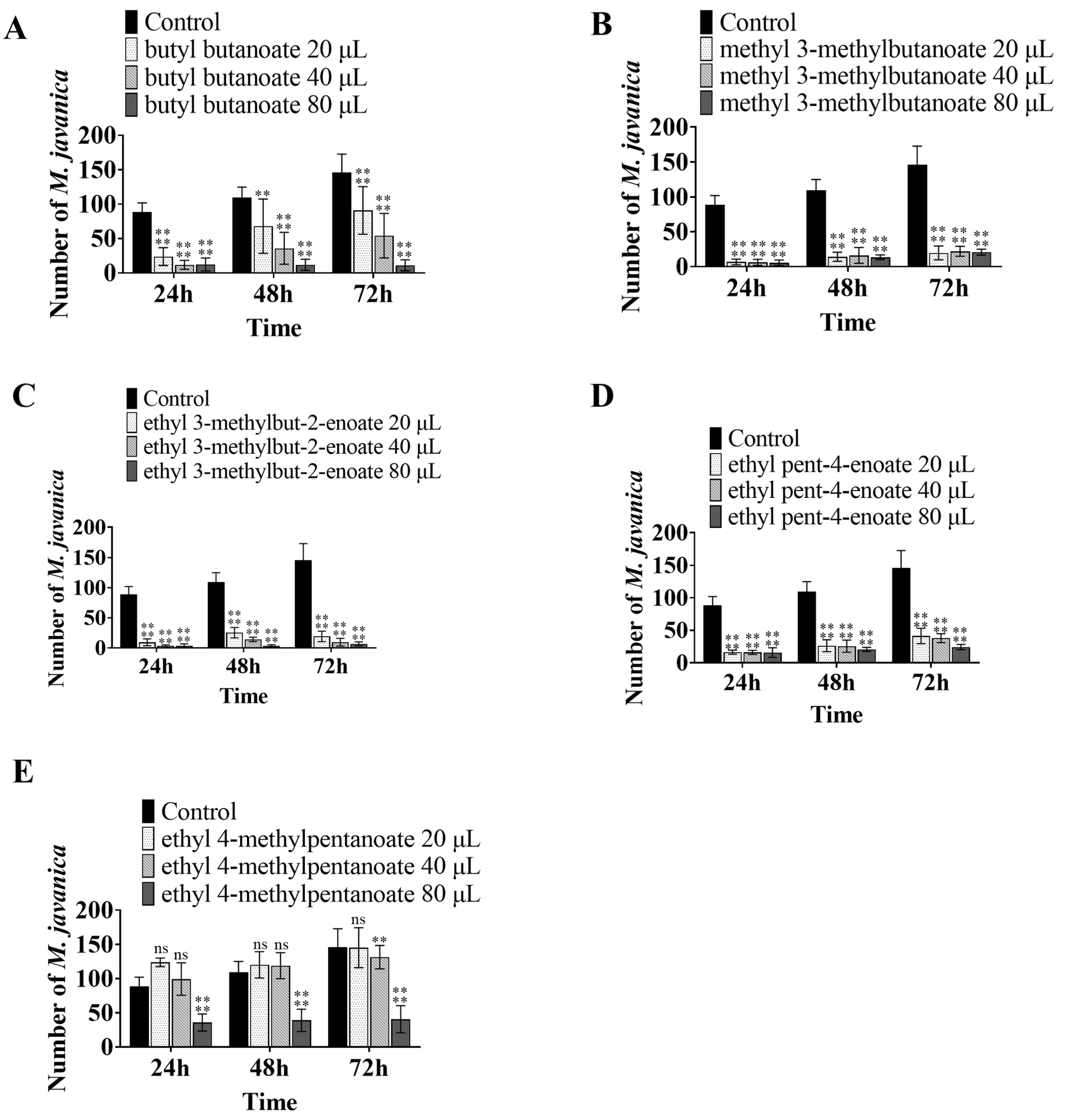Volatile Metabolites from Brevundimonas diminuta and Nematicidal Esters Inhibit Meloidogyne javanica
Abstract
:1. Introduction
2. Materials and Methods
2.1. Experimental Strain and Culture
2.2. Assay of Nematicidal Activity of Fermentation Broth against M. javanica
2.3. Gas Chromatography–Mass Spectrometry Analysis
2.4. Nematicidal Activity of the Volatile Metabolites
2.5. Ability of the Volatile Metabolites to Inhibit Egg Hatching
2.6. Data Analysis and Statistics
3. Results
3.1. Nematicidal Activity of the B. diminuta Fermentation Broth against M. javanica
3.2. Identification of VOCs Produced by B. diminuta
3.3. Nematicidal Activity of the VOCs Produced by B. diminuta
3.4. Nematicidal Activity of the Volatile Ester Compounds
3.5. Inhibition of Egg-Hatching Activity by Volatile Ester Compounds
4. Discussion
5. Conclusions
Supplementary Materials
Author Contributions
Funding
Data Availability Statement
Conflicts of Interest
References
- Elling, A.A. Major Emerging Problems with Minor Meloidogyne Species. Phytopathology 2013, 103, 1092–1102. [Google Scholar] [CrossRef] [PubMed] [Green Version]
- Jones, J.T.; Haegeman, A.; Danchin, E.G.J.; Gaur, H.S.; Helder, J.; Jones, M.G.K.; Kikuchi, T.; Manzanilla-López, R.; Palomares-Rius, J.E.; Wesemael, W.M.L.; et al. Top 10 plant-parasitic nematodes in molecular plant pathology. Mol. Plant Pathol. 2013, 14, 946–961. [Google Scholar] [CrossRef] [PubMed] [Green Version]
- Tapia-Vázquez, I.; Montoya-Martínez, A.C.; De los Santos-Villalobos, S.; Ek-Ramos, M.J.; Montesinos-Matías, R.; Martínez-Anaya, C. Root-knot nematodes (Meloidogyne spp.) a threat to agriculture in Mexico: Biology, current control strategies, and perspectives. World J. Microbiol. Biotechnol. 2022, 38, 26. [Google Scholar] [CrossRef]
- Andrés, M.F.; González-Coloma, A.; Sanz, J.; Burillo, J.; Sainz, P. Nematicidal activity of essential oils: A review. Phytochem. Rev. 2012, 11, 371–390. [Google Scholar] [CrossRef] [Green Version]
- Piao, X.; Sun, M.; Yi, F. Evaluation of Nematocidal Action against Caenorhabditis elegans of Essential Oil of Flesh Fingered Citron and Its Mechanism. J. Chem. 2020, 2020, 1740938. [Google Scholar] [CrossRef] [Green Version]
- Deng, X.; Wang, X.; Li, G. Nematicidal Effects of Volatile Organic Compounds from Microorganisms and Plants on Plant-Parasitic Nematodes. Microorganisms 2022, 10, 1201. [Google Scholar] [CrossRef]
- Grimme, E.; Zidack, N.K.; Sikora, R.A.; Strobel, G.A.; Jacobsen, B.J. Comparison of Muscodor albus Volatiles with a Biorational Mixture for Control of Seedling Diseases of Sugar Beet and Root-Knot Nematode on Tomato. Plant Dis. 2007, 91, 220–225. [Google Scholar] [CrossRef] [Green Version]
- Aissani, N.; Urgeghe, P.P.; Oplos, C.; Saba, M.; Tocco, G.; Petretto, G.L.; Eloh, K.; Menkissoglu-Spiroudi, U.; Ntalli, N.; Caboni, P. Nematicidal Activity of the Volatilome of Eruca sativa on Meloidogyne incognita. J. Agric. Food Chem. 2015, 63, 6120–6125. [Google Scholar] [CrossRef]
- Ntalli, N.G.; Vargiu, S.; Menkissoglu-Spiroudi, U.; Caboni, P. Nematicidal Carboxylic Acids and Aldehydes from Melia azedarach Fruits. J. Agric. Food Chem. 2010, 58, 11390–11394. [Google Scholar] [CrossRef]
- Caboni, P.; Ntalli, N.G.; Aissani, N.; Cavoski, I.; Angioni, A. Nematicidal Activity of (E,E)-2,4-Decadienal and (E)-2-Decenal from Ailanthus altissima against Meloidogyne javanica. J. Agric. Food Chem. 2012, 60, 1146–1151. [Google Scholar] [CrossRef]
- Wolfgang, A.; Taffner, J.; Guimarães, R.A.; Coyne, D.; Berg, G. Novel Strategies for Soil-Borne Diseases: Exploiting the Microbiome and Volatile-Based Mechanisms Toward Controlling Meloidogyne Based Disease Complexes. Front. Microbiol. 2019, 10, 1296. [Google Scholar] [CrossRef] [PubMed] [Green Version]
- Ayaz, M.; Ali, Q.; Farzand, A.; Khan, A.R.; Ling, H.; Gao, X. Nematicidal Volatiles from Bacillus atrophaeus GBSC56 Promote Growth and Stimulate Induced Systemic Resistance in Tomato against Meloidogyne incognita. Int. J. Mol. Sci. 2021, 22, 5049. [Google Scholar] [CrossRef] [PubMed]
- Huang, Y.; Xu, C.; Ma, L.; Zhang, K.; Duan, C.; Mo, M. Characterisation of volatiles produced from Bacillus megaterium YFM3.25 and their nematicidal activity against Meloidogyne incognita. Eur. J. Plant Pathol. 2010, 126, 417–422. [Google Scholar] [CrossRef]
- Luo, T.; Hou, S.; Yang, L.; Qi, G.; Zhao, X. Nematodes avoid and are killed by Bacillus mycoides produced styrene. J. Invertebr. Pathol. 2018, 159, 129–136. [Google Scholar] [CrossRef]
- Yin, N.; Liu, R.; Zhao, J.L.; Khan, R.A.A.; Li, Y.; Ling, J.; Liu, W.; Yang, Y.H.; Xie, B.Y.; Mao, Z.C. Volatile Organic Compounds of Bacillus cereus Strain Bc-cm103 Exhibit Fumigation Activity against Meloidogyne incognita. Plant Dis. 2021, 105, 904–911. [Google Scholar] [CrossRef]
- Yang, L.-L.; Huang, Y.; Liu, J.; Ma, L.; Mo, M.-H.; Li, W.-J.; Yang, F.-X. Lysinibacillus mangiferahumi sp. nov., a new bacterium producing nematicidal volatiles. Antonie Leeuwenhoek 2012, 102, 53–59. [Google Scholar] [CrossRef]
- Cheng, W.; Yang, J.; Nie, Q.; Huang, D.; Yu, C.; Zheng, L.; Cai, M.; Thomashow, L.S.; Weller, D.M.; Yu, Z.; et al. Volatile organic compounds from Paenibacillus polymyxa KM2501-1 control Meloidogyne incognita by multiple strategies. Sci. Rep. 2017, 7, 16213. [Google Scholar] [CrossRef] [PubMed] [Green Version]
- Xu, Y.-Y.; Lu, H.; Wang, X.; Zhang, K.-Q.; Li, G.-H. Effect of Volatile Organic Compounds from Bacteria on Nematodes. Chem. Biodiversity 2015, 12, 1415–1421. [Google Scholar] [CrossRef] [PubMed]
- Huang, D.; Hao, Y.U.; Wen, C.; Wanli, C.; Zongze, S.; Jibin, Z. Identification and characteristics of 4-vinylphenol from Virgibacillus dokdonensis MCCC 1A00493 against Meloidogyne incognita. Acta Microbiol. Sin. 2022, 62, 346–356. [Google Scholar]
- Huang, D.; Yu, C.; Shao, Z.; Cai, M.; Li, G.; Zheng, L.; Yu, Z.; Zhang, J. Identification and Characterization of Nematicidal Volatile Organic Compounds from Deep-Sea Virgibacillus dokdonensis MCCC 1A00493. Molecules 2020, 25, 744. [Google Scholar] [CrossRef]
- Yu, J.; Du, G.C.; Li, R.G.; Li, L.; Li, Z.; Zhou, C.J.; Chen, C.C.; Guo, D.S. Nematicidal activities of bacterial volatiles and components from two marine bacteria, Pseudoalteromonas marina strain H-42 and Vibrio atlanticus strain S-16, against the pine wood nematode, Bursaphelenchus xylophilus. Nematology 2015, 17, 1011–1025. [Google Scholar] [CrossRef]
- Bowman, F.W.; Calhoun, M.P.; White, M. Microbiological Methods for Quality Control of Membrane Filters. J. Pharm. Sci. 1967, 56, 222–225. [Google Scholar] [CrossRef]
- Singh, N.; Marwa, N.; Mishra, S.K.; Mishra, J.; Verma, P.C.; Rathaur, S.; Singh, N. Brevundimonas diminuta mediated alleviation of arsenic toxicity and plant growth promotion in Oryza sativa L. Ecotoxicol. Environ. Saf. 2016, 125, 25–34. [Google Scholar] [CrossRef] [PubMed]
- Ali, A.; Li, M.; Su, J.; Li, Y.; Wang, Z.; Bai, Y.; Ali, E.F.; Shaheen, S.M. Brevundimonas diminuta isolated from mines polluted soil immobilized cadmium (Cd2+) and zinc (Zn2+) through calcium carbonate precipitation: Microscopic and spectroscopic investigations. Sci. Total Environ. 2022, 813, 152668. [Google Scholar] [CrossRef]
- Joshi, M.H.; Patil, A.A.; Chaudhary, S.; Kale, R.D. Microbial synthesis of CuNPs using Brevundimonas diminuta strain and its antibacterial activity. Adv. Nat. Sci. Nanosci. Nanotechnol. 2020, 11, 15008. [Google Scholar] [CrossRef]
- Liu, Y.; Chang, H.; Li, Z.; Feng, Y.; Cheng, D.; Xue, J. Biodegradation of gentamicin by bacterial consortia AMQD4 in synthetic medium and raw gentamicin sewage. Sci. Rep. 2017, 7, 11004. [Google Scholar] [CrossRef] [Green Version]
- Abdel-Khalek, N.; Selim, K.; Abdallah, S.; Yassin, K. Bioflotation of low Grade Egyptian Iron ore using Brevundimonas diminuta Bacteria: Phosphorus removal. Elixir Bio Technol. 2013, 63, 18666–18670. [Google Scholar]
- Saravanan, S.; Carolin, C.F.; Kumar, P.S.; Chitra, B.; Rangasamy, G. Biodegradation of textile dye Rhodamine-B by Brevundimonas diminuta and screening of their breakdown metabolites. Chemosphere 2022, 308, 136266. [Google Scholar] [CrossRef]
- Hossain, M.S.; Chowdhury, M.A.Z.; Pramanik, M.K.; Rahman, M.A.; Fakhruddin, A.N.M.; Alam, M.K. Determination of selected pesticides in water samples adjacent to agricultural fields and removal of organophosphorus insecticide chlorpyrifos using soil bacterial isolates. Appl. Water Sci. 2014, 5, 171–179. [Google Scholar] [CrossRef] [Green Version]
- Wang, X.; Wang, X.; Liu, M.; Zhou, L.; Gu, Z.; Zhao, J. Bioremediation of marine oil pollution by Brevundimonas diminuta: Effect of salinity and nutrients. Desalin. Water Treat. 2015, 57, 19768–19775. [Google Scholar] [CrossRef]
- Kavitha, S.; Selvakumar, R.; Sathishkumar, M.; Swaminathan, K.; Lakshmanaperumalsamy, P.; Singh, A.; Jain, S.K. Nitrate removal using Brevundimonas diminuta MTCC 8486 from ground water. Water Sci. Technol. 2009, 60, 517–524. [Google Scholar] [CrossRef]
- Rathi, M.; Yogalakshmi, K.N. Brevundimonas diminuta MYS6 associated Helianthus annuus L. for enhanced copper phytoremediation. Chemosphere 2021, 263, 128195. [Google Scholar] [CrossRef] [PubMed]
- Kwon, H.-K.; Jung, J.-O. Isolation and Characteristics of Novel Ammonia Oxidizing Bacteria Brevundimonas diminuta. Korean J. Environ. Health Sci. 2007, 33, 293–298. [Google Scholar] [CrossRef] [Green Version]
- Mirhendi, M.; Emtiazi, G.; Roghanian, R. Production of nano zinc, zinc sulphide and nanocomplex of magnetite zinc oxide by Brevundimonas diminuta and Pseudomonas stutzeri. IET Nanobiotechnol. 2013, 7, 135–139. [Google Scholar] [CrossRef] [PubMed]
- Basuki, W. Biodegradation of Used Synthetic Lubricating Oil by Brevundimonas diminuta AKL 1.6. Makara J. Sci. 2017, 21, 136–142. [Google Scholar] [CrossRef]
- Oh, M.-H.; Lee, E.-Y. Reduction of Sulfur Compounds Produced from Swine Manure, Using Brevundimonas diminuta. Microbiol. Biotechnol. Lett. 2017, 45, 257–264. [Google Scholar] [CrossRef]
- Kruszewska, H.; Misicka, A.; Chmielowiec, U. Biodegradation of DNA and nucleotides to nucleosides and free bases. Farmaco 2004, 59, 13–20. [Google Scholar] [CrossRef] [PubMed]
- Kasai, N.; Arata, S.; Mashimo, J.-i.; Akiyama, Y.; Tanaka, C.; Egawa, K.; Tanaka, S. Pseudomonas diminuta LPS with a new endotoxic lipid A structure. Biochem. Biophys. Res. Commun. 1987, 142, 972–978. [Google Scholar] [CrossRef]
- Liu, R.; Bao, Z.-X.; Li, G.-H.; Li, C.-Q.; Wang, S.-L.; Pan, X.-R.; Zhang, K.-Q.; Zhao, P. Identification of Nematicidal Metabolites from Purpureocillium lavendulum. Microorganisms 2022, 10, 1343. [Google Scholar] [CrossRef]
- Gu, Y.-Q.; Mo, M.-H.; Zhou, J.-P.; Zou, C.-S.; Zhang, K.-Q. Evaluation and identification of potential organic nematicidal volatiles from soil bacteria. Soil Biol. Biochem. 2007, 39, 2567–2575. [Google Scholar] [CrossRef]
- Popova, A.A.; Koksharova, O.A.; Lipasova, V.A.; Zaitseva, J.V.; Katkova-Zhukotskaya, O.A.; Eremina, S.I.; Mironov, A.S.; Chernin, L.S.; Khmel, I.A. Inhibitory and Toxic Effects of Volatiles Emitted by Strains of Pseudomonas and Serratia on Growth and Survival of Selected Microorganisms, Caenorhabditis elegans and Drosophila melanogaster. BioMed. Res. Int. 2014, 2014, 125704. [Google Scholar] [CrossRef] [PubMed] [Green Version]
- Zhang, X.; Guan, P.; Wang, Y.; Li, Q.; Zhang, S.; Zhang, Z.; Bezemer, T.m.; Liang, W. Community composition, diversity and metabolic footprints of soil nematodes in differently-aged temperate forests. Soil Biol. Biochem. 2015, 80, 118–126. [Google Scholar] [CrossRef]
- Arthurs, S.; Dara, S.K. Microbial biopesticides for invertebrate pests and their markets in the United States. J. Invertebr. 2019, 165, 13–21. [Google Scholar] [CrossRef] [PubMed]
- Ma, Y.-y.; Li, Y.-l.; Lai, H.-x.; Guo, Q.; Xue, Q.-h. Effects of two strains of Streptomyces on root-zone microbes and nematodes for biocontrol of root-knot nematode disease in tomato. Appl. Soil Ecol. 2017, 112, 34–41. [Google Scholar] [CrossRef]
- Zhai, Y.; Shao, Z.; Cai, M.; Zheng, L.; Li, G.; Yu, Z.; Zhang, J. Cyclo(l-Pro–l-Leu) of Pseudomonas putida MCCC 1A00316 Isolated from Antarctic Soil: Identification and Characterization of Activity against Meloidogyne incognita. Molecules 2019, 24, 768. [Google Scholar] [CrossRef] [Green Version]
- Pagans, E.; Font, X.; Sanchez, A. Emission of volatile organic compounds from composting of different solid wastes: Abatement by biofiltration. J. Hazard. Mater. 2006, 131, 179–186. [Google Scholar] [CrossRef] [Green Version]
- Chen, W.; Wang, J.; Huang, D.; Cheng, W.; Shao, Z.; Cai, M.; Zheng, L.; Ziniu, y.; Zhang, J. Volatile Organic Compounds from Bacillus aryabhattai MCCC 1K02966 with Multiple Modes against Meloidogyne incognita. Molecules 2021, 27, 103. [Google Scholar] [CrossRef]
- Giner, M.; Avilla, J.; Balcells, M.; Caccia, S.; Smagghe, G. Toxicity of allyl esters in insect cell lines and in Spodoptera littoralis larvae. Arch. Insect Biochem. Physiol. 2012, 79, 18–30. [Google Scholar] [CrossRef]
- Silva, M.; Campos, V.; Terra, W.; Magalhães Pacheco, P.; Paula, L.; Barros, A.; Pedroso, M. Volatile fatty acids from whey volatilome as potential soil fumigants to control Meloidogyne incognita. Crop Prot. 2021, 143, 105567. [Google Scholar] [CrossRef]
- Zhai, Y.; Shao, Z.; Cai, M.; Zheng, L.; Li, G.; Huang, D.; Cheng, W.; Thomashow, L.S.; Weller, D.M.; Yu, Z.; et al. Multiple Modes of Nematode Control by Volatiles of Pseudomonas putida 1A00316 from Antarctic Soil against Meloidogyne incognita. Front. Microbiol. 2018, 9, 253. [Google Scholar] [CrossRef] [Green Version]




| Components | CAS No. | Formula | Molecular Weight | RT (min) | Area % | Qual % |
|---|---|---|---|---|---|---|
| butyl butanoate | 109-21-7 | C8H16O2 | 144 | 10.61 | 0.45 | 91 |
| 2-(1-hydroxycyclohexyl)cyclohexan-1-one | 28746-99-8 | C12H20O2 | 196 | 30.76 | 0.88 | 86 |
| 2-(cyclohexen-1-yl)cyclohexan-1-one | 1502-22-3 | C12H18O | 178 | 28.73 | 0.55 | 83 |
| tetradecane | 629-59-4 | C14H30 | 198 | 25.31 | 0.84 | 98 |
| butylcyclohexane | 1678-93-9 | C10H20 | 140 | 11.97 | 0.35 | 97 |
| dodecane | 112-40-3 | C12H26 | 170 | 19.00 | 0.3 | 94 |
| bis(6-methylheptyl) benzene-1,2-dicarboxylate | 27554-26-3 | C24H38O4 | 391 | 49.52 | 6.99 | 91 |
| dibutyl benzene-1,2-dicarboxylate | 84-74-2 | C16H22O4 | 278 | 38.77 | 0.56 | 96 |
| (6E,10E,14E,18E)-2,6,10,15,19,23-hexamethyltetracosa-2,6,10,14,18,22-hexaene | 111-02-4 | C30H50 | 411 | 53.68 | 0.31 | 98 |
| cyclohexylcyclohexane | 92-51-3 | C12H22 | 166 | 22.33 | 0.67 | 96 |
| Compounds | Mortality of M. javanica (%) ± SD |
|---|---|
| 24 h | |
| butyl butanoate | 93.75 ± 0.02 |
| 2-(1-hydroxycyclohexyl)cyclohexan-1-one | 1.80 ± 0.01 |
| 2-(cyclohexen-1-yl)cyclohexan-1-one | 11.39 ± 0.08 |
| tetradecane | 0.37 ± 0.01 |
| butylcyclohexane | 0.71 ± 0.01 |
| dodecane | 0.65 ± 0.01 |
| bis(6-methylheptyl) benzene-1,2-dicarboxylate | 0.37 ± 0.01 |
| dibutyl benzene-1,2-dicarboxylate | 2.24 ± 0.01 |
| (6E,10E,14E,18E)-2,6,10,15,19,23-hexamethyltetracosa-2,6,10,14,18,22-hexaene | 0.70 ± 0.00 |
| cyclohexylcyclohexane | 0 ± 0.00 |
| control | 0.71 ± 0.01 |
Disclaimer/Publisher’s Note: The statements, opinions and data contained in all publications are solely those of the individual author(s) and contributor(s) and not of MDPI and/or the editor(s). MDPI and/or the editor(s) disclaim responsibility for any injury to people or property resulting from any ideas, methods, instructions or products referred to in the content. |
© 2023 by the authors. Licensee MDPI, Basel, Switzerland. This article is an open access article distributed under the terms and conditions of the Creative Commons Attribution (CC BY) license (https://creativecommons.org/licenses/by/4.0/).
Share and Cite
Sun, Y.; Ran, Y.; Yang, H.; Mo, M.; Li, G. Volatile Metabolites from Brevundimonas diminuta and Nematicidal Esters Inhibit Meloidogyne javanica. Microorganisms 2023, 11, 966. https://doi.org/10.3390/microorganisms11040966
Sun Y, Ran Y, Yang H, Mo M, Li G. Volatile Metabolites from Brevundimonas diminuta and Nematicidal Esters Inhibit Meloidogyne javanica. Microorganisms. 2023; 11(4):966. https://doi.org/10.3390/microorganisms11040966
Chicago/Turabian StyleSun, Yongxiang, Yuan Ran, Hanbo Yang, Minghe Mo, and Guohong Li. 2023. "Volatile Metabolites from Brevundimonas diminuta and Nematicidal Esters Inhibit Meloidogyne javanica" Microorganisms 11, no. 4: 966. https://doi.org/10.3390/microorganisms11040966
APA StyleSun, Y., Ran, Y., Yang, H., Mo, M., & Li, G. (2023). Volatile Metabolites from Brevundimonas diminuta and Nematicidal Esters Inhibit Meloidogyne javanica. Microorganisms, 11(4), 966. https://doi.org/10.3390/microorganisms11040966






